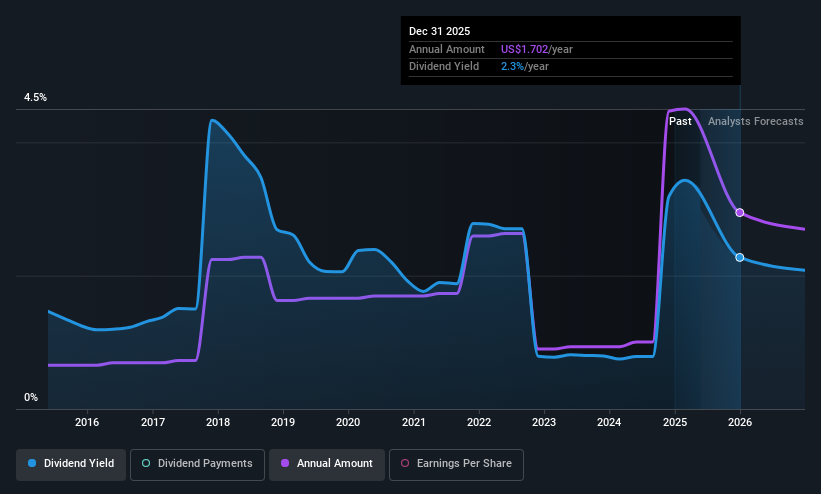RLI Corp. (NYSE:RLI) Passed Our Checks, And It's About To Pay A US$0.16 Dividend
Readers hoping to buy RLI Corp. (NYSE:RLI) for its dividend will need to make their move shortly, as the stock is about to trade ex-dividend. The ex-dividend date is one business day before the record date, which is the cut-off date for shareholders to be present on the company's books to be eligible for a dividend payment. The ex-dividend date is an important date to be aware of as any purchase of the stock made on or after this date might mean a late settlement that doesn't show on the record date. Therefore, if you purchase RLI's shares on or after the 30th of May, you won't be eligible to receive the dividend, when it is paid on the 20th of June.
The company's next dividend payment will be US$0.16 per share, on the back of last year when the company paid a total of US$2.60 to shareholders. Based on the last year's worth of payments, RLI has a trailing yield of 3.5% on the current stock price of US$74.86. If you buy this business for its dividend, you should have an idea of whether RLI's dividend is reliable and sustainable. We need to see whether the dividend is covered by earnings and if it's growing.
If a company pays out more in dividends than it earned, then the dividend might become unsustainable - hardly an ideal situation. RLI has a low and conservative payout ratio of just 19% of its income after tax.
When a company paid out less in dividends than it earned in profit, this generally suggests its dividend is affordable. The lower the % of its profit that it pays out, the greater the margin of safety for the dividend if the business enters a downturn.
View our latest analysis for RLI
Click here to see the company's payout ratio, plus analyst estimates of its future dividends.

Have Earnings And Dividends Been Growing?
Businesses with strong growth prospects usually make the best dividend payers, because it's easier to grow dividends when earnings per share are improving. If earnings decline and the company is forced to cut its dividend, investors could watch the value of their investment go up in smoke. With that in mind, we're encouraged by the steady growth at RLI, with earnings per share up 7.4% on average over the last five years.
Many investors will assess a company's dividend performance by evaluating how much the dividend payments have changed over time. In the past 10 years, RLI has increased its dividend at approximately 22% a year on average. It's encouraging to see the company lifting dividends while earnings are growing, suggesting at least some corporate interest in rewarding shareholders.
The Bottom Line
Is RLI an attractive dividend stock, or better left on the shelf? RLI has seen its earnings per share grow slowly in recent years, and the company reinvests more than half of its profits in the business, which generally bodes well for its future prospects. In summary, RLI appears to have some promise as a dividend stock, and we'd suggest taking a closer look at it.
In light of that, while RLI has an appealing dividend, it's worth knowing the risks involved with this stock. In terms of investment risks, we've identified 1 warning sign with RLI and understanding them should be part of your investment process.
If you're in the market for strong dividend payers, we recommend checking our selection of top dividend stocks.
Have feedback on this article? Concerned about the content? Get in touch with us directly. Alternatively, email editorial-team (at) simplywallst.com.
This article by Simply Wall St is general in nature. We provide commentary based on historical data and analyst forecasts only using an unbiased methodology and our articles are not intended to be financial advice. It does not constitute a recommendation to buy or sell any stock, and does not take account of your objectives, or your financial situation. We aim to bring you long-term focused analysis driven by fundamental data. Note that our analysis may not factor in the latest price-sensitive company announcements or qualitative material. Simply Wall St has no position in any stocks mentioned.
 Wall Street Journal
Wall Street Journal